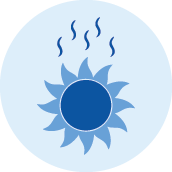StormsNgā āwhā
Storms can happen any time of the year. They can bring strong winds, heavy rain or snow, thunder, lightning, tornadoes and rough seas. Find out what to do before, during and after a storm.
On this page
About storms
In New Zealand, we have a lot of natural hazards. Earthquakes, floods, landslides, severe weather, tsunami, volcanic activity, and other hazards can happen any time and often without warning.
Storms can happen any time of the year. They can bring strong winds, heavy rain or snow, thunder, lightning, tornadoes and rough seas.
You can reduce the impact of storms by regularly inspecting and trimming trees and shrubbery. Strong winds frequently break weak tree limbs and throw them at great speed. They can cause damage and injury.
You should also review your insurance regularly. Having insurance cover for your home and contents is important to help you get back on your feet if you suffer damage in a disaster.

We can't predict disasters, but we can prepare for them. One of the best places to start is with your home. Find out what you can do to make your home safer.
Get ready before a storm
Get ready before a storm.
- Keep up to date with MetService weather forecasts.
- Work out what supplies you might need and make a plan with your whānau. Have materials and tools ready to repair windows, such as tarpaulins, boards and duct tape.
- Identify a safe place in your home to gather during a thunderstorm. This should be a place where there are no windows, skylights, or glass doors. These could break in strong winds or hail and cause damage or injury.
- Know which paddocks are safe if you have livestock. To prevent risks from lightning, move livestock away from:
- floodwaters
- landslides
- power lines, and
- isolated trees.
Prepare your property for high winds. Strong winds can lift large, heavy objects and send them crashing into homes. Anything not secured may become a projectile.
Tie down your trampoline and other heavy outdoor objects. Remove anything that could become a damaging missile.
Make a list of items to bring inside or tie down when strong winds are forecast. A list will help you remember anything that strong winds can break or pick up.

Make a plan online with your whānau to get through an emergency. Think about the things you need every day and work out what you would do if you didn't have them.

In an emergency, you may be stuck at home for three days or more. Your house is already full of emergency items disguised as everyday things. Figure out what supplies you need and make a plan to get through.
When a storm is forecast
When a storm is forecast, bring inside or tie down anything that strong winds could break or pick up. If you have a trampoline, turn it upside down to minimise the surface area exposed to wind.
Remove any debris or loose items from around your property. Branches and firewood can become missiles in strong winds.
Bring pets indoors. They can get unsettled by storms and it is more comforting and safer for them to be with you.
Check on your neighbours and anyone who might need your help.
What to do during a storm
Know what to do during a storm.
- Stay inside. Don't walk around outside. Don't drive unless absolutely necessary.
- Close exterior and interior doors and windows. Pull curtains and blinds over windows. This could prevent injury from flying glass if the window breaks.
- Stay informed. Follow your Civil Defence Emergency Management Group online. Follow the instructions of civil defence and emergency services.
- Avoid bathtubs, water taps, and sinks. Metal pipes and plumbing can conduct electricity if struck by lightning. Use your water from your emergency supplies.
- Unplug small appliances that may be affected by electrical power surges. If you lose power, unplug major appliances. This will reduce the power surge and possible damage when power is restored.
Snowstorms
In a snowstorm
In a snowstorm, you could lose heat and power. You may have a shortage of supplies if storm conditions continue for more than a day.
If you live in a region at risk of snowstorms, try have more than one form of power generation and heating. Check fuel supplies for woodburners, gas heaters, barbeques and generators.
Stay up to date with the latest weather information from MetService. Pay attention to heavy snow warnings and road snowfall warnings. Avoid leaving home unless absolutely necessary when a snow warning is issued.
If you have to travel make sure you are well prepared. Take snow chains, sleeping bags, warm clothing and essential emergency items.
If you are in your car or truck in a snowstorm, stay in your vehicle. Run the engine every ten minutes to keep warm. Drink fluids to avoid dehydration. Open the window a little to avoid carbon monoxide poisoning. Make yourself visible to rescuers. Tie a bright-coloured cloth to your radio aerial or door and keep the inside light on.
Tornadoes
Tornadoes sometimes occur during thunderstorms in some parts of New Zealand. A tornado is a narrow, rotating column of air. It extends downwards to the ground from the base of a thunderstorm.
If you see a tornado funnel nearby, take shelter immediately. If you have one, shelter in a basement or an inside room with no windows or outside doors on the ground floor. Get under sturdy furniture and cover yourself with a mattress or blanket.
Alert others, if you can.
If you’re caught outside, get away from trees if you can. Lie down flat in a nearby gully, ditch or low spot and protect your head.
If you’re in a car, get out immediately and look for a safe place to shelter. Do not try to outrun a tornado or get under your vehicle for shelter.
Tornadoes
Tornadoes sometimes occur during thunderstorms in some parts of New Zealand. A tornado is a narrow, rotating column of air. It extends downwards to the ground from the base of a thunderstorm.
If you see a tornado funnel nearby, take shelter immediately. If you have one, shelter in a basement or an inside room with no windows or outside doors on the ground floor. Get under sturdy furniture and cover yourself with a mattress or blanket.
Alert others, if you can.
If you’re caught outside, get away from trees if you can. Lie down flat in a nearby gully, ditch or low spot and protect your head.
If you’re in a car, get out immediately and look for a safe place to shelter. Do not try to outrun a tornado or get under your vehicle for shelter.

Find your local Civil Defence Emergency Management (CDEM) Group.
What to do after a storm
After a storm, stay informed by following your Civil Defence Emergency Management Group online. They will give you information and instructions.
Check for injuries and get first aid if necessary.
Help others if you can, especially people who may need extra help.
Contact your local council if your house or building has been severely damaged. Ask your council for advice on how to clean up debris safely.
Stay alert for extended rainfall, flooding, landslides and debris hazards, especially when driving.
If your property is damaged:
- Do not do anything that puts your safety at risk or causes more damage to your property.
- Contact your insurance company as soon as possible.
- If you rent your property, contact your landlord and your contents insurance company.
- Take photos of any damage. It will help speed up assessments of your claims.

First aid saves lives. Learn what to look for and what to do if you need to give first aid on the St John website.
Severe weather warnings
MetService provides land-based severe weather alerts. These are issued through a system of Outlooks, Watches and Warnings.
Outlooks provide a 'heads up' that bad weather is coming in the next 3–6 days but there is some uncertainty about what might happen and where. Stay alert to the forecast and be prepared that you may be affected.
Watches are used when severe weather is possible, but not imminent or certain. When a Watch is in place, stay alert and keep an eye on your local forecast for updates.
Orange warnings are used when bad weather will meet Severe Weather Criteria. This could be heavy rain, strong wind or heavy snow.
When there is an Orange Warning, be prepared and take action as appropriate as there could be some disruption to your day and potential risk to people, animals and property. The majority of warnings issued by MetService will be orange.
Red warnings are used for extreme weather events that are likely to have significant impact and disruption. This could be for weather like heavy rain, strong wind or heavy snow from events like cyclones.
When there is a Red Warning, act now. Immediate action is needed to protect people, animals and property. Be prepared to follow the advice of official authorities and emergency services.
Types of hazards | Ngā momo matepā
In New Zealand we have a lot of natural hazards. Find out what to do before, during and after each type of emergency.










